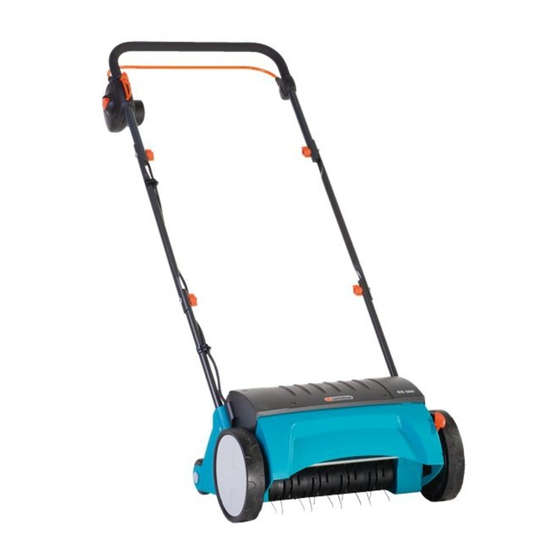Gardena ES 500 사용 설명서 - 페이지 3
{카테고리_이름} Gardena ES 500에 대한 사용 설명서을 온라인으로 검색하거나 PDF를 다운로드하세요. Gardena ES 500 9 페이지. Electric lawn rake
Gardena ES 500에 대해서도 마찬가지입니다: 사용 설명서 (12 페이지), 운영자 매뉴얼 (15 페이지), 운영자 매뉴얼 (15 페이지), 운영자 매뉴얼 (15 페이지), 운영자 매뉴얼 (9 페이지), 운영자 매뉴얼 (9 페이지)

S harp prongs can
cause injury!
v U nplug from the mains before m aintenance
or if the mains lead is d amaged.
v K eep mains connection lead away
from the Electric Lawn Rake.
Checksbeforeeachuse:
v I nspect the Electric Lawn Rake before
each use.
v D o not use the Electric Lawn Rake if safety
devices (starter lever, safety interlock,
rear flap, housing) are damaged or worn.
v N ever operate the unit with the safety
devices by-passed or missing.
v N ote: Ensure that all nuts, bolts and screws
are tight and that the Electric Lawn Rake is
in good w orking order.
For safety reasons, allow all worn out and
damaged parts to be exchanged by GARDENA
Service or authorised specialist dealers.
v I nspect the area to be aerated before
b eginning work.
v C heck the working area for foreign objects
(e.g. stones, branches, string) and remove if
necessary.
Properuse/Responsibility:
DANGER! Risk of injury!
The Electric Lawn Rake can cause
serious injuries!
v K eep hands and feet away from the
a erator cylinder.
You are responsible for the safety of the
w orking area.
v O nly use the Electric Lawn Rake for the
p ur p oses specified in these instructions.
v O nly work when visibility is good.
v D uring use do not tip the unit and do not
open the rear flap.
v F amiliarise yourself with the surroundings of
your working area. Check for possible risks
which might be not audible due to the noise
of the machine.
v W ear sturdy shoes and long trousers to
p rotect your legs.
v E nsure you keep your feet a safe distance
from the moving parts.
v M ake sure that there are no other people
(especially children) or animals anywhere
near the working area.
12
v A lways push the Electric Lawn Rake at
a walking pace.
v O perating position: Ensure that you have
a secure foothold when working.
v B e particularly careful if you change direction
on a slope.
Attention! Take extra care when walking
backwards. You may stumble!
v D o not use the Electric Lawn Rake if it is
r aining or in moist, wet conditions.
v D o not work close to the edge of swimming
pools or garden ponds with the Electric
Lawn Rake.
v P lease observe any local restrictions relating
to noise levels.
Electricalsafety:
v K eep the extension cable away from the
aerator cylinder!
v N ever use the Electric Lawn Rake when it is
r aining.
v P lease observe the prescribed local quiet
times.
v T he connecting / extension cable must be
checked regularly for damage and signs of
wear and tear.
v D isconnect the mains plug immediately if the
connecting / extension cable is damaged or
severed.
Never touch the mains connection cable
before the mains plug has been removed
from the socket.
The coupling socket for the extension cable
must be waterproof for protection from
water splashes or the connection sockets for
e xtension cables must be made of rubber or
be encased in rubber.
Only use extension cables authorised in
a ccordance with HD 516.
v A sk your electrician.
v O nly use approved extension cables with the
correct load rating.
v A sk your electrician.
Attachment fittings must be used for extension
cables.
For portable units, which are used outdoors,
we recommend to use a residual-current device
having a residual-current rating ≤ 30 mA.
In Switzerland use of a residual-current device
is obligatory.
Interruptionsofwork:
Never leave the Electric Lawn Rake
u nattended at the working area.
v I f you interrupt your work store the unit in
a safe place. Disconnect the mains plug!
v W hen you interrupt work in order to go to
another working area, always switch off
the Electric Lawn Rake during transport.
Put the wear compensation lever in the
transport position.
3. Function
Correctaerating:
The Electric Lawn Rake can be used for removing matting and
moss in the lawn as well as for cutting flat-rooting ranks.
To maintain a well-cared-for lawn we recommend aerating every
4 – 6 weeks depending on the state of your lawn.
v F irst of all, mow your lawn to the length you require.
We particularly recommend this if the grass has grown tall
(e.g. while you were away on holiday).
Recommendation: the shorter you mow your lawn, the easier
it is to aerate, thus lessening the strain on the Electric Lawn Rake
and i ncreasing the lifetime of the aerator cylinder.
Remaining in one spot too long, or aerating if the ground is wet or
too dry can damage the grass.
v F or good results, guide the Electric Lawn Rake at an
a ppropriate speed in strips as straight as possible across
your lawn.
To avoid leaving any gaps during aerating, the strips should
touch.
v A lways guide the Electric Lawn Rake at an even speed
d epending on the type of ground.
v W hen working on inclines always stand diagonally to the incline
in a sturdy, safe stance. Do not work on extremely steep slopes.
Danger of tripping!
To prevent tripping take particular care when moving
b ackwards and when pulling the Electric Lawn Rake.
When aerating areas of very mossy lawn we recommend resowing
the lawn after aerating. This helps the areas of lawn which were
replaced by moss to regenerate more quickly.
Ifyoucomeintocontactwithan
obstructionduringaerating:
1. Turn off the Electric Lawn Rake.
2. Remove the obstruction.
3. C heck the Electric Lawn Rake for damage
and have it repaired if necessary.
13
